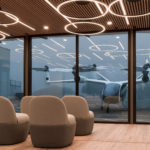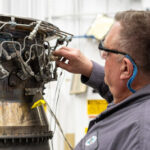Two years ago, the UK city of Coventry hosted a three-week experiment in urban air mobility, with the establishment of Air One – a vertiport demonstrator built on Westminster car park in the city centre, immediately next to the train station and a 10 minute walk from the central shopping district.
The builder was Urban-Air Port, created to design, develop, manufacture, sell and operate ground, air and digital infrastructure for new forms of sustainable urban air transport such as air taxis and autonomous delivery drones. The ultra-dense location serving Coventry’s population of close to 400,000 people aligned with the city’s future plans to establish a new intermodal infrastructure, connecting to and complementing existing infrastructure and encouraging greener modes of transportation such as e-bikes and e-scooters for final mile delivery.
Chief executive Andrea Wu was at this week’s Connected Places summit in London to discuss the lessons learned from the Air One exercise. FINN caught up with her at the event to glean some insight into her experience of trying to get the Advanced Air Mobility (AAM) industry off the ground.
Air One didn’t host any commercial flights, but visitors were treated to about 100 drone movements. The purpose was to show how “ultra compact” purpose-built infrastructure can support the potential of AAM. As Wu (pictured fourth from left at the Air One presentation) told FINN, the message from Air One and Urban-Air Port’s longer experience is that eVTOL travel ultimately needs support from local and central government and the public, along with important technical factors like sufficient electricity supply. But the big issue facing infrastructure operators like Urban-Air Port is the commercial case for operating.
Critically, she says, everyone involved needs to expect that vertiports will follow a commercial pattern like other infrastructure projects such as airports and rail stations. That is, they need to expect to lose money for several years before hopefully settling into a sustainable, profitable routine.
In that regard, non-aero partners – such as retailers – are an important part of the infrastructure, a facet which was a feature of Air One.
Wu notes that no-one in the AAM sector has an answer. The 2024 Paris Olympics, for example, will feature an AAM technology demonstration – but it will be a showcase, not a commercial prospect.
So for Urban Air-Port, a post-Coventry focus of attention is to “look to create a blueprint for the business”. That means, for example, looking seriously at how a vertiport can partner with electricity suppliers to keep costs under control and working out how non-aero partners can deliver meaningful revenue.
Another critical question to answer is, what routes are likely to be profitable, and thus support the necessary investment in infrastructure? Because there are as yet no commercial operations, she notes, there is no data to address this issue. That’s another reason the industry must be prepared to lose money in its early years – just like other infrastucture projects.
To get started, then, a vertiport model must be able to start small and scale up as demand and requirements become clear. But ultimately, the industry needs to get started, or it will forever be trying to model its business case on guesswork.
As Wu later told delegates to Connected Places: “We must really do it. It’s the only way to move away from this whitepaper exercise.”
Subscribe to the FINN weekly newsletter
You may also be interested in
Vigilant detect-avoid system for DronePort Network US vertiports

